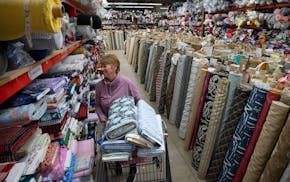Opinion editor's note: Strib Voices publishes a mix of commentary online and in print each day. To contribute, click here.
•••
This column is the launch of a series of occasional columns regarding mental health in Minnesota. The series will chronicle ongoing struggles, emerging progress and voices of hope.
When I was 10, an early spring melted a babbling stream along our school playground in northern Minnesota. At recess, my friends and I raced boats made of sticks. Mine was a smooth piece of heartwood that didn't quite float but rather bobbed just under the water.
As we returned to class soaking wet, Mrs. Robinson said that my parents wanted me to go home on the bus rather than to Scouts. At our house, speaking in hushed and broken tones, mom and dad told my sisters and me that our uncle Scott died the day before from something called suicide.
Our family changed forever that day. In some ways, our society has also dramatically changed. What's most strikingly different now is our desire to honestly address and relieve the symptoms of mental illness. Much of the shame and stigma has been stripped away. Not all of it; but enough for necessary and tough conversations. That's why I'm sharing a very deeply personal story and many others in a new series of columns about mental health in Minnesota.
What can anyone actually remember of an uncle who died when you were 10? Mostly, I remember that I called Scott my favorite uncle.
He left the Iron Range for the Twin Cities before I was born, returning to family gatherings wearing clean button-up shirts. Scott was a drafter for Caterpillar, designing equipment that fascinated my elementary school friends and me. He was the only water-skier my dad couldn't dump behind the family speedboat on Ely Lake despite numerous violent attempts. Scott lit up when I told him I wanted to be an engineer like him someday. Actually, I hated math. But I loved my uncle.
That night I overheard my father's broken voice on a phone call: "He was sick. I just have to tell myself that he was sick, and that's all it was."
Childhood memories like that stick with you. But my most vivid memory was of the way that my uncle's name slipped out of family conversation.
Scott suffered from mental illness. Depression, yes, but more than that: delusions, hallucinations and other symptoms I knew nothing about as a kid. He found comfort in church, becoming an active member of an Assemblies of God congregation in Minnetonka. His faith community provided spiritual support, but ultimately his symptoms worsened. A momentary crisis led to awful finality and then silence.
It was this family silence that would define the years to come. Mental illness and addiction would shape our household during my teenage years, too. At 18, I moved out for good, fleeing a home riddled with the symptoms of deep depression and alcoholism. I created distance from the problem but brought it with me. These same afflictions would become part of my story, too. By grace, we are all doing OK today.
"People weren't talking about it before," said Sue Abderholden, executive director of the Minnesota chapter of the National Alliance for Mental Illness. "You didn't know before if people were struggling."
In my phone interview with Abderholden, she said she's seen massive growth in the willingness of people from all walks of life to talk about mental health over the past 20 years.
Since my uncle's death in 1990, the treatment of mental illness has improved considerably. People in his situation today are more likely to live and thrive.
But a changing world taxes our well-being and creates unnatural strain on a poorly designed mental health care system.
"We're definitely in a crisis," said Abderholden. "No doubt about it. The system isn't broken. It was never built."
Increasingly, law enforcement officers become the first contact for those struggling, a fact that weighs heavily on the criminal justice system.
Rural Minnesotans face unique strain, detailed in a 2024 report from the Center for Rural Policy and Development and the Center for Rural Behavioral Health at Minnesota State University, Mankato. Suicide rates in northeastern Minnesota, for instance, are the highest in the state, twice that of the seven-county Twin Cities metropolitan area. Northwestern Minnesota is a close second.
Monica McConkey, a mental health counselor who lives near Detroit Lakes, serves rural Minnesota clients.
"Definitely, the lowest number of calls [for help] I get is from the north," she said. "Isolation. Stigma. They say, 'I don't need help; I don't want to bother anyone.' People just don't want to rely on anyone."
To top it off, most us carry around a small, rectangular, app-filled mental health crisis in our pockets. Technological change cannot be discounted as a factor in mental health challenges.
And yet, despite it all, a beautiful truth prevails.
"Recovery is possible," said Abderholden. "People need to know they can get better. They can get there. They're not alone. There are lots of people who live with a mental illness."
Last year, I had a dream. I met my father at one of those old-fashioned roadside supper clubs that once dotted the Minnesota landscape. We wound our way through the crowded dining room, past wall-mounted antlers and dark wood trim. Dad paused to talk to a man at one of the tables. I waited patiently until we took our seats in the other room. I asked who that was, and he said it was Scott.
It hit me all at once. I hadn't recognized him. I burst into tears before waking up. It was just a dream, but the tears were real.
A writer can't bring back the dead, though this one will try to save somebody. The mental health stigmas of the past are mercifully fading away. We need not remain silent anymore. Over the next few weeks, I'll share stories from around Minnesota about gains in mental health care, the unfinished work, and the hope that life allows, if we listen.
Brown: Relying on law enforcement to solve mental health crisis puts lives at risk
Brown: The good, bad and ugly of Trump's blessing U.S. Steel, Nippon deal

Brown: As once-giant Joann Fabrics shutters its doors, the DIYers must sew our economy back together

